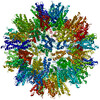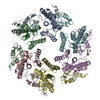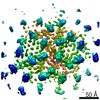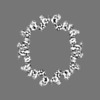+ データを開く
データを開く
- 基本情報
基本情報
| 登録情報 | データベース: EMDB / ID: EMD-12486 | |||||||||||||||
|---|---|---|---|---|---|---|---|---|---|---|---|---|---|---|---|---|
| タイトル | Structure of the mature RSV CA lattice: T=3 CA icosahedron | |||||||||||||||
 マップデータ マップデータ | RSV CA lattice: T=3 icosahedron | |||||||||||||||
 試料 試料 |
| |||||||||||||||
 キーワード キーワード | Retrovirus / Rous sarcoma virus / capsid protein / IP6 / VIRAL PROTEIN | |||||||||||||||
| 機能・相同性 |  機能・相同性情報 機能・相同性情報host cell nucleoplasm / viral procapsid maturation / host cell nucleolus / 加水分解酵素; プロテアーゼ; ペプチド結合加水分解酵素; アスパラギン酸プロテアーゼ / viral capsid / structural constituent of virion / aspartic-type endopeptidase activity / nucleic acid binding / viral translational frameshifting / host cell plasma membrane ...host cell nucleoplasm / viral procapsid maturation / host cell nucleolus / 加水分解酵素; プロテアーゼ; ペプチド結合加水分解酵素; アスパラギン酸プロテアーゼ / viral capsid / structural constituent of virion / aspartic-type endopeptidase activity / nucleic acid binding / viral translational frameshifting / host cell plasma membrane / proteolysis / zinc ion binding / membrane 類似検索 - 分子機能 | |||||||||||||||
| 生物種 |  Rous sarcoma virus (strain Prague C) (ラウス肉腫ウイルス) / Rous sarcoma virus (strain Prague C) (ラウス肉腫ウイルス) /  Rous sarcoma virus - Prague C (ラウス肉腫ウイルス) Rous sarcoma virus - Prague C (ラウス肉腫ウイルス) | |||||||||||||||
| 手法 | 単粒子再構成法 / クライオ電子顕微鏡法 / 解像度: 7.6 Å | |||||||||||||||
 データ登録者 データ登録者 | Obr M / Ricana CL | |||||||||||||||
| 資金援助 |  オーストリア, オーストリア,  米国, 4件 米国, 4件
| |||||||||||||||
 引用 引用 |  ジャーナル: Nat Commun / 年: 2021 ジャーナル: Nat Commun / 年: 2021タイトル: Structure of the mature Rous sarcoma virus lattice reveals a role for IP6 in the formation of the capsid hexamer. 著者: Martin Obr / Clifton L Ricana / Nadia Nikulin / Jon-Philip R Feathers / Marco Klanschnig / Andreas Thader / Marc C Johnson / Volker M Vogt / Florian K M Schur / Robert A Dick /   要旨: Inositol hexakisphosphate (IP6) is an assembly cofactor for HIV-1. We report here that IP6 is also used for assembly of Rous sarcoma virus (RSV), a retrovirus from a different genus. IP6 is ~100-fold ...Inositol hexakisphosphate (IP6) is an assembly cofactor for HIV-1. We report here that IP6 is also used for assembly of Rous sarcoma virus (RSV), a retrovirus from a different genus. IP6 is ~100-fold more potent at promoting RSV mature capsid protein (CA) assembly than observed for HIV-1 and removal of IP6 in cells reduces infectivity by 100-fold. Here, visualized by cryo-electron tomography and subtomogram averaging, mature capsid-like particles show an IP6-like density in the CA hexamer, coordinated by rings of six lysines and six arginines. Phosphate and IP6 have opposing effects on CA in vitro assembly, inducing formation of T = 1 icosahedrons and tubes, respectively, implying that phosphate promotes pentamer and IP6 hexamer formation. Subtomogram averaging and classification optimized for analysis of pleomorphic retrovirus particles reveal that the heterogeneity of mature RSV CA polyhedrons results from an unexpected, intrinsic CA hexamer flexibility. In contrast, the CA pentamer forms rigid units organizing the local architecture. These different features of hexamers and pentamers determine the structural mechanism to form CA polyhedrons of variable shape in mature RSV particles. | |||||||||||||||
| 履歴 |
|
- 構造の表示
構造の表示
| ムービー |
 ムービービューア ムービービューア |
|---|---|
| 構造ビューア | EMマップ:  SurfView SurfView Molmil Molmil Jmol/JSmol Jmol/JSmol |
| 添付画像 |
- ダウンロードとリンク
ダウンロードとリンク
-EMDBアーカイブ
| マップデータ |  emd_12486.map.gz emd_12486.map.gz | 25.7 MB |  EMDBマップデータ形式 EMDBマップデータ形式 | |
|---|---|---|---|---|
| ヘッダ (付随情報) |  emd-12486-v30.xml emd-12486-v30.xml emd-12486.xml emd-12486.xml | 14.9 KB 14.9 KB | 表示 表示 |  EMDBヘッダ EMDBヘッダ |
| 画像 |  emd_12486.png emd_12486.png | 226.8 KB | ||
| Filedesc metadata |  emd-12486.cif.gz emd-12486.cif.gz | 6.2 KB | ||
| アーカイブディレクトリ |  http://ftp.pdbj.org/pub/emdb/structures/EMD-12486 http://ftp.pdbj.org/pub/emdb/structures/EMD-12486 ftp://ftp.pdbj.org/pub/emdb/structures/EMD-12486 ftp://ftp.pdbj.org/pub/emdb/structures/EMD-12486 | HTTPS FTP |
-検証レポート
| 文書・要旨 |  emd_12486_validation.pdf.gz emd_12486_validation.pdf.gz | 448.4 KB | 表示 |  EMDB検証レポート EMDB検証レポート |
|---|---|---|---|---|
| 文書・詳細版 |  emd_12486_full_validation.pdf.gz emd_12486_full_validation.pdf.gz | 448 KB | 表示 | |
| XML形式データ |  emd_12486_validation.xml.gz emd_12486_validation.xml.gz | 7 KB | 表示 | |
| CIF形式データ |  emd_12486_validation.cif.gz emd_12486_validation.cif.gz | 7.9 KB | 表示 | |
| アーカイブディレクトリ |  https://ftp.pdbj.org/pub/emdb/validation_reports/EMD-12486 https://ftp.pdbj.org/pub/emdb/validation_reports/EMD-12486 ftp://ftp.pdbj.org/pub/emdb/validation_reports/EMD-12486 ftp://ftp.pdbj.org/pub/emdb/validation_reports/EMD-12486 | HTTPS FTP |
-関連構造データ
| 関連構造データ |  7no1MC  7no0C  7no2C  7no3C  7no4C  7no5C  7no6C  7no7C  7no8C  7no9C  7noaC  7nobC  7nocC  7nodC  7noeC  7nofC  7nogC  7nohC  7noiC  7nojC  7nokC  7nolC  7nomC  7nonC  7nooC  7nopC  7noqC M: このマップから作成された原子モデル C: 同じ文献を引用 ( |
|---|---|
| 類似構造データ |
- リンク
リンク
| EMDBのページ |  EMDB (EBI/PDBe) / EMDB (EBI/PDBe) /  EMDataResource EMDataResource |
|---|
- マップ
マップ
| ファイル |  ダウンロード / ファイル: emd_12486.map.gz / 形式: CCP4 / 大きさ: 178 MB / タイプ: IMAGE STORED AS FLOATING POINT NUMBER (4 BYTES) ダウンロード / ファイル: emd_12486.map.gz / 形式: CCP4 / 大きさ: 178 MB / タイプ: IMAGE STORED AS FLOATING POINT NUMBER (4 BYTES) | ||||||||||||||||||||||||||||||||||||||||||||||||||||||||||||
|---|---|---|---|---|---|---|---|---|---|---|---|---|---|---|---|---|---|---|---|---|---|---|---|---|---|---|---|---|---|---|---|---|---|---|---|---|---|---|---|---|---|---|---|---|---|---|---|---|---|---|---|---|---|---|---|---|---|---|---|---|---|
| 注釈 | RSV CA lattice: T=3 icosahedron | ||||||||||||||||||||||||||||||||||||||||||||||||||||||||||||
| 投影像・断面図 | 画像のコントロール
画像は Spider により作成 | ||||||||||||||||||||||||||||||||||||||||||||||||||||||||||||
| ボクセルのサイズ | X=Y=Z: 1.24 Å | ||||||||||||||||||||||||||||||||||||||||||||||||||||||||||||
| 密度 |
| ||||||||||||||||||||||||||||||||||||||||||||||||||||||||||||
| 対称性 | 空間群: 1 | ||||||||||||||||||||||||||||||||||||||||||||||||||||||||||||
| 詳細 | EMDB XML:
CCP4マップ ヘッダ情報:
| ||||||||||||||||||||||||||||||||||||||||||||||||||||||||||||
-添付データ
- 試料の構成要素
試料の構成要素
-全体 : Rous sarcoma virus - Prague C
| 全体 | 名称:  Rous sarcoma virus - Prague C (ラウス肉腫ウイルス) Rous sarcoma virus - Prague C (ラウス肉腫ウイルス) |
|---|---|
| 要素 |
|
-超分子 #1: Rous sarcoma virus - Prague C
| 超分子 | 名称: Rous sarcoma virus - Prague C / タイプ: virus / ID: 1 / 親要素: 0 / 含まれる分子: all / NCBI-ID: 11888 / 生物種: Rous sarcoma virus - Prague C / ウイルスタイプ: VIRUS-LIKE PARTICLE / ウイルス・単離状態: OTHER / ウイルス・エンベロープ: No / ウイルス・中空状態: Yes |
|---|---|
| ウイルス殻 | Shell ID: 1 / 名称: T=3 icosahedron |
-分子 #1: Capsid protein p27, alternate cleaved 1
| 分子 | 名称: Capsid protein p27, alternate cleaved 1 / タイプ: protein_or_peptide / ID: 1 / コピー数: 3 / 光学異性体: LEVO |
|---|---|
| 由来(天然) | 生物種:  Rous sarcoma virus (strain Prague C) (ラウス肉腫ウイルス) Rous sarcoma virus (strain Prague C) (ラウス肉腫ウイルス)株: Prague C |
| 分子量 | 理論値: 24.773594 KDa |
| 組換発現 | 生物種:  |
| 配列 | 文字列: PVVIKTEGPA WTPLEPKLIT RLADTVRTKG LRSPITMAEV EALMSSPLLP HDVTNLMRVI LGPAPYALWM DAWGVQLQTV IAAATRDPR HPANGQGRGE RTNLNRLKGL ADGMVGNPQG QAALLRPGEL VAITASALQA FREVARLAEP AGPWADIMQG P SESFVDFA ...文字列: PVVIKTEGPA WTPLEPKLIT RLADTVRTKG LRSPITMAEV EALMSSPLLP HDVTNLMRVI LGPAPYALWM DAWGVQLQTV IAAATRDPR HPANGQGRGE RTNLNRLKGL ADGMVGNPQG QAALLRPGEL VAITASALQA FREVARLAEP AGPWADIMQG P SESFVDFA NRLIKAVEGS DLPPSARAPV IIDCFRQKSQ PDIQQLIRTA PSTLTTPGEI IKYVLDRQKT A UniProtKB: Gag polyprotein |
-実験情報
-構造解析
| 手法 | クライオ電子顕微鏡法 |
|---|---|
 解析 解析 | 単粒子再構成法 |
| 試料の集合状態 | particle |
- 試料調製
試料調製
| 緩衝液 | pH: 8 / 構成要素 - 濃度: 1.0 M / 構成要素 - 式: NaPi / 構成要素 - 名称: sodium phosphate |
|---|---|
| グリッド | モデル: C-flat-2/2 / 材質: COPPER / メッシュ: 300 / 支持フィルム - 材質: CARBON / 支持フィルム - トポロジー: HOLEY / 前処理 - タイプ: GLOW DISCHARGE / 前処理 - 時間: 45 sec. / 前処理 - 雰囲気: AIR |
| 凍結 | 凍結剤: ETHANE / チャンバー内湿度: 95 % / チャンバー内温度: 277 K / 装置: FEI VITROBOT MARK IV / 詳細: blot time = 2.5s blot force = 0. |
- 電子顕微鏡法
電子顕微鏡法
| 顕微鏡 | FEI TECNAI ARCTICA |
|---|---|
| 特殊光学系 | エネルギーフィルター - 名称: GIF Bioquantum / エネルギーフィルター - スリット幅: 20 eV |
| 撮影 | フィルム・検出器のモデル: GATAN K3 BIOQUANTUM (6k x 4k) デジタル化 - サイズ - 横: 5760 pixel / デジタル化 - サイズ - 縦: 4092 pixel / 実像数: 2394 / 平均露光時間: 3.0 sec. / 平均電子線量: 50.0 e/Å2 |
| 電子線 | 加速電圧: 200 kV / 電子線源:  FIELD EMISSION GUN FIELD EMISSION GUN |
| 電子光学系 | C2レンズ絞り径: 50.0 µm / 照射モード: FLOOD BEAM / 撮影モード: BRIGHT FIELD / Cs: 2.7 mm / 最大 デフォーカス(公称値): 1.5 µm / 最小 デフォーカス(公称値): 0.8 µm / 倍率(公称値): 63000 |
| 試料ステージ | 試料ホルダーモデル: FEI TITAN KRIOS AUTOGRID HOLDER ホルダー冷却材: NITROGEN |
| 実験機器 |  モデル: Talos Arctica / 画像提供: FEI Company |
 ムービー
ムービー コントローラー
コントローラー









































 Z (Sec.)
Z (Sec.) Y (Row.)
Y (Row.) X (Col.)
X (Col.)






















